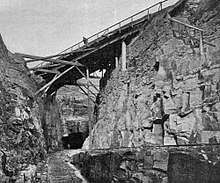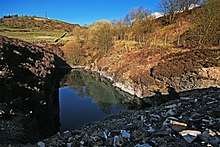Queensbury Tunnel
Queensbury Tunnel is a disused railway tunnel that connects Holmfield and Queensbury in West Yorkshire, England. It was built by the Great Northern Railway (GNR) and, at 2,501 yards (2,287 metres) in length, was the longest on the company's network at the time of its opening in 1878.[1] The tunnel is owned by the Department for Transport and maintained on its behalf by Highways England's Historical Railways Estate (HRE).
Construction

Queensbury Tunnel was one of several major engineering feats on the Halifax, Thornton and Keighley Railway, one of the so-called Queensbury Lines. Plans for this route were placed before Parliament in 1873, with Royal Assent being granted on 5 August after several months of debate.[2]
The tunnel and its approach cuttings comprised almost the entirety of Railway No.3 which extended for 2.25 miles (3.62 km) from Holmfield Station to the triangular interchange at Queensbury where trains could diverge to either Bradford or Keighley. The Great Northern Railway appointed John Fraser as engineer whilst his son Henry acted as resident engineer. Benton and Woodiwiss, a company with a longstanding association with the GNR, was contracted to build it.[3]
Work on the northernmost of the construction shafts got underway in May 1874.[4] It was originally intended that eight shafts would be sunk, however their spacing was changed at an early stage, resulting in No.7 shaft not being progressed. The contract required the tunnel to be completed within two years, but this proved impossible due to significant water ingress forcing the abandonment of two other shafts, including No.5 which would have been the deepest at 414 feet (126 metres).[5]
In July 1877, Colonel Frederick Beaumont, chairman of the Diamond Rock Boring Company, brought a rock drilling machine to Queensbury which was used to speed up the driving of headings (pilot tunnels) from the bottom of No.4 shaft. This improved the productivity of the miners by four or five-fold and resulted in the breakthrough of a continuous heading from one end of the tunnel to the other on 2 October 1877,[5] although there was still a need to excavate the tunnel to full size and construct the lining.
Structural work on the tunnel was finished in July 1878. The last brick was inserted by the inspector, Mr Albrighton, who had supervised work on the tunnel from the outset. The event was marked by the flying of colours from the headgear of No.4 shaft,[6] following which the Great Northern Railway entertained 300 of the workmen to a dinner.
At least ten men died during construction of the tunnel. Miners Henry Jones, 39, and John Gough, 40, were killed when a charge exploded as they attempted to withdraw it. Of the others, Richard Sutcliffe was struck by a cage which fell down a shaft, John Swire was run over by wagons, Henry Ingham drowned at the bottom of a shaft, Sutcliffe Hodgson fell down a shaft, Richard Jones was crushed by falling rock, Llewellyn Jones was injured in an explosion and succumbed to tetanus, Frederick Goulding was crushed by a wagon, and Captain Pickles was struck on the head by a large timber.[7]
Operational period
Railway No.3 was inspected by Major General C S Hutchinson on behalf of the Board of Trade on 11 October 1878, stating that "I must report that by reason of the incompleteness of the work (viz. the want of a terminal station) the Halifax Thornton and Keighley Railway and its westerly fork cannot be opened for passenger traffic without danger to the public".[8] Goods trains started to use the line almost immediately, but passenger services were not introduced until 1 December 1879.[9]
In 1882, defects were found in the arch and sidewalls at several locations through the tunnel, caused by poor workmanship and the effects of adjacent mine workings. This resulted in the imposition of single-line working for the first nine months of 1883 whilst repairs were carried out.[10] Subsidence and water ingress continued to have an impact through the tunnel's operational period, prompting an extensive programme of patch repairs to the arch in the 1920s and the relining of No.3 shaft in 1934.[11]
In April 1906, foreman ganger Sam Hirst was knocked down by a train in the tunnel and lost one of his feet.[12] On the night of 24 March 1944, fireman Henry Kilner looked out of the cab as his train approached the tunnel, resulting in him striking his head on the brickwork. He sustained lacerations and concussion.[13]
Although passenger revenue declined due to tram and bus competition, freight traffic remained relatively buoyant until the 1940s. However the high cost of maintenance, in part due to Queensbury Tunnel, made the line a prime candidate for closure as part of post-war economy measures. With passenger services already withdrawn, the section of line from Holmfield to Queensbury West closed on 28 May 1956. Track lifting through the tunnel took place in 1963.[14]

After closure
In July 1969, an early prototype of an invar wire strainmeter was installed in Queensbury Tunnel as part of research by a team of scientists from the University of Cambridge into Earth strain.[15] Following the project's conclusion, the facility was retained and expanded. Recording equipment was housed in a hut close to No.4 shaft which was often slept in by members of the University’s geophysics department. The facility was closed in November 1979.[16]
In 1991, scientists from British Rail's Research Centre carried out experiments into the effectiveness of new waterproof grout which was injected through the lining at locations close to the northernmost shaft.[17]
Queensbury Tunnel is built on a gradient of 1 in 100 (1%), falling to the south. Due to the amount of water entering the tunnel and the infilling of its southern approach cutting, severe flooding has affected it since the 1980s. During periods of heavy rain, the floodwater has reached a depth of approximately 35 feet (10.7 metres) at the south portal, extending into the tunnel by almost half its length.

Withdrawal of its maintenance regime after closure prompted a considerable deterioration in the tunnel's condition. In 2013–2014, two partial collapses occurred close to its midpoint. A number of severe bulges have also been recorded, as well as deep, longitudinal spalling to the south of No.4 shaft. Without intervention, engineers assert that this section is likely to suffer further collapses in years to come.[18]
The Institution of Civil Engineers designated Queensbury Tunnel a Historical Engineering Work in June 2016.[19]
Abandonment
Plans for the formal abandonment of Queensbury Tunnel were included in a report developed by Jacobs, an engineering consultancy, for BRB (Residuary) Ltd in October 2009. It recommended that the tunnel should be infilled from both entrances for a distance of 150 metres, substructure plugs placed beneath the five completed ventilation shafts, and all seven shafts backfilled and capped. Jacobs estimated the cost of this work would be £5.125 million. A programme of remedial works to permit safe man entry was costed at £1.975 million.[20]
Jacobs submitted a second study – the Queensbury Tunnel Options Report – to the Historical Railways Estate in February 2016. This was not progressed beyond the draft stage, however HRE decided to move forward with two of the options outlined in it. The first requires the tunnel to be infilled from both entrances for a distance of 20 metres; the second involves backfilling the five ventilation shafts. The estimated cost of this work is £3 million.[21]
Cycle path proposal

In 2014, a local heritage group proposed that Queensbury Tunnel should be repaired and reopened as part of the Great Northern Trail cycle path, as one element of a vision to revitalise the fortunes of Queensbury village. Robert Goodwill MP, who at the time was Parliamentary Under-Secretary of State for Transport, visited the tunnel on 23 June 2014 to hear from the group.[22] He subsequently asked HRE to develop a costing for the tunnel's repair and this was undertaken by Jacobs as part of its Options Report. The work took the form of a high-level desk study and resulted in an estimated cost of £35.4 million being put before the Minister in March 2016. He ruled this out as too expensive, allowing HRE to make progress with its abandonment plans.[18]
The heritage group sought the help of a tunnel engineer and civil engineering contractor to develop its own repair scheme in summer 2016. Costed at £2.8 million, this was published in October 2016[18] and coincided with the formation of the Queensbury Tunnel Society (QTS) to provide an ongoing focus for the reopening campaign.
A study by Sustrans, published in August 2017, indicated that a network of cycle paths connecting Bradford and Keighley to Halifax, via the tunnel, could generate £37.6 million in economic benefits over 30 years.[23]
In September 2017, it was announced that HRE had agreed to fund independent investigations by Bradford Council into the condition of the tunnel, repair options and associated costs. These will be used to inform a Council decision on whether it can accept a transfer of the tunnel's ownership from HRE, without which the cycle path proposal [24] cannot move forward. As part of any transfer, HRE would provide a dowry of £3.2 million – the estimated cost of abandonment – to fund repairs to the tunnel.[25] If no transfer is agreed, work to abandon the tunnel will begin in autumn 2018.
Location
- Northern portal: 53°46′26″N 1°50′37″W / 53.7739°N 1.8437°W
- Southern portal: 53°45′35″N 1°52′07″W / 53.75972°N 1.86861°W
References
- ↑ Blower, Alan (1964). British Railway Tunnels. London: Ian Allan. p. 46. OCLC 930427607.
- ↑ "Sheffield Telegraph". 6 August 1873.
- ↑ "Leeds Times". 19 October 1878.
- ↑ "Halifax Courier". 23 May 1874.
- 1 2 Adams, G F (1877). "The Maesteg Tunnel". South Wales Institute of Engineers: Proceedings. 10 (6): 318. OCLC 174170003.
- ↑ "Halifax Courier". 13 July 1878.
- ↑ "Those Who Gave Their Lives" (PDF). Queensbury Tunnel Society. March 2017. p. 6.
- ↑ Report of the Commissioners of Railways. 1878.
- ↑ Grinling, Charles H (1898). The History of the Great Northern Railway 1845-1895. London: Methuen & Co. p. 338. OCLC 735055.
- ↑ Queensbury Tunnel, repairs to, caused by movement of coal workings: Engineer's reports. National Archives. 1882–1883. RAIL 236/344/16.
- ↑ Construction drawings held in the archive of Network Rail.
- ↑ "Leeds Mercury". 3 April 1906.
- ↑ "Yorkshire Post". 25 March 1944.
- ↑ Great Northern Outpost (Volume 2). Willowherb Publishing. 2017. p. 89. ISBN 978-0-9935678-1-0.
- ↑ Burton, Paul W (1972). "Earth Strain Tides Observed in Yorkshire, England with a Simple Wire Strainmeter". Geophysical Journal International. Volume 29.
- ↑ Burton, Paul W (1981). "Seismological Research in the United Kingdom, 1980". Quarterly Journal of the Royal Astronomical Society: 98.
- ↑ "Bradford Telegraph and Argus". 3 May 1991.
- 1 2 3 "Queensbury Tunnel: Asset or Liability" (PDF). Queensbury Tunnel Society. October 2016.
- ↑ "Panel For Historical Engineering Works". Institution of Civil Engineers. June 2016.
- ↑ "Feasibility Study of Future Asset Management". BRB (Residuary) Ltd/Jacobs: 44–45. October 2009.
- ↑ "Appendix B". Queensbury Tunnel Options Report. Highways England Historical Railways Estate/Jacobs. February 2016.
- ↑ "VIDEO: Government minister's praise for Queensbury tunnel cycle plans". Bradford Telegraph & Argus. 23 June 2014.
- ↑ "Estimating the economic impact of reopening walking and cycling routes around Queensbury Tunnel" (PDF). Sustrans. June 2017.
- ↑ "VIDEO: Campaigners create virtual cycle ride through Queensbury Tunnel in a bid to secure site for future generations". Bradford Telegraph & Argus. 8 August 2017.
- ↑ Ian Hirst (27 September 2017). "Structure investigation into Queensbury tunnel as society hopes to re-open it as cycle path". Halifax Courier.
External links
- History of the tunnel from Forgotten Relics
- Queensbury Tunnel Society